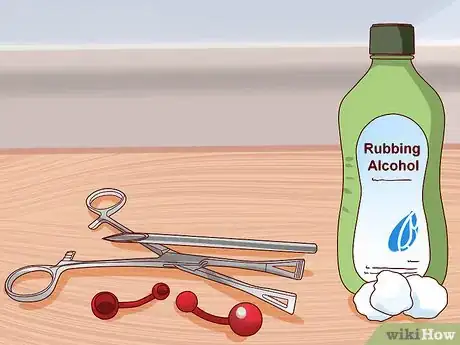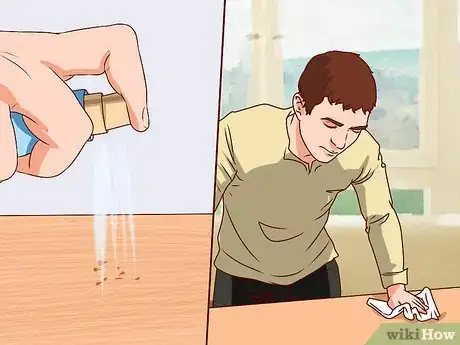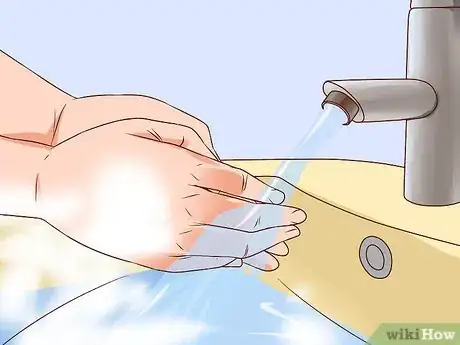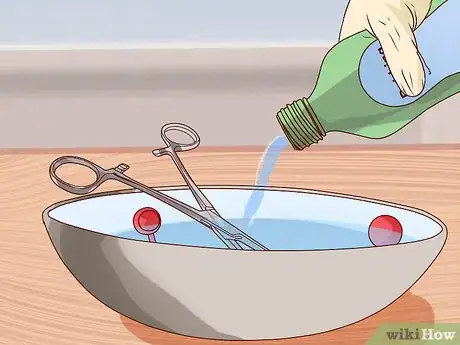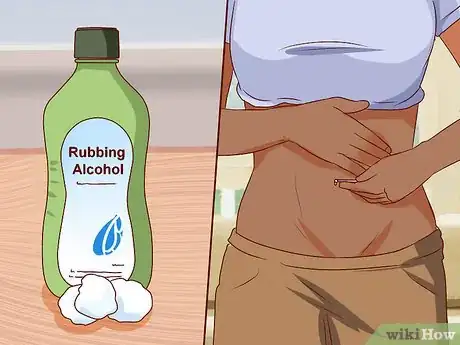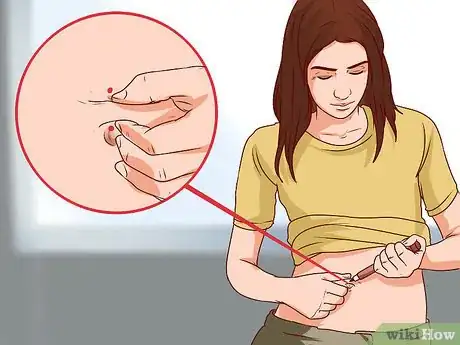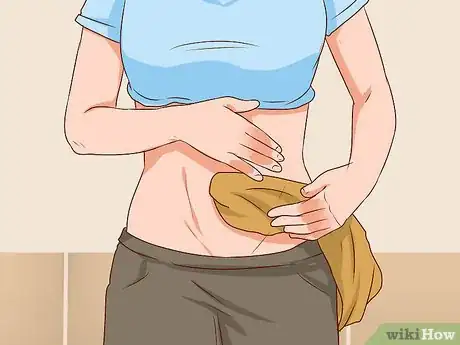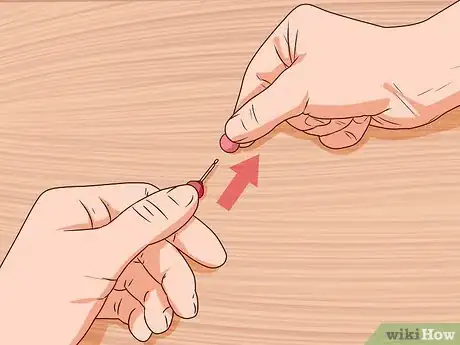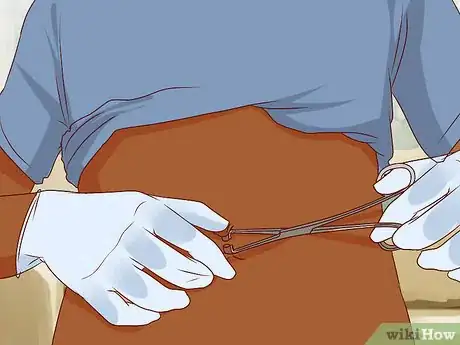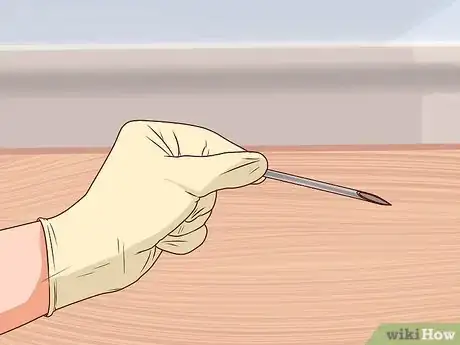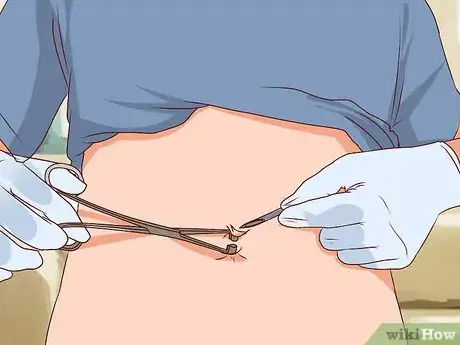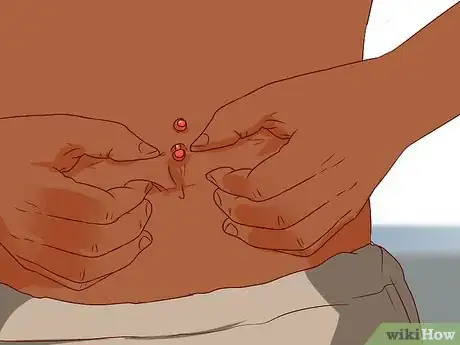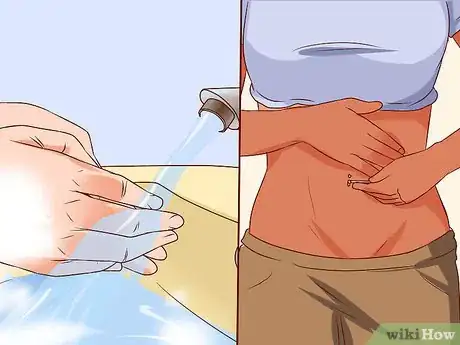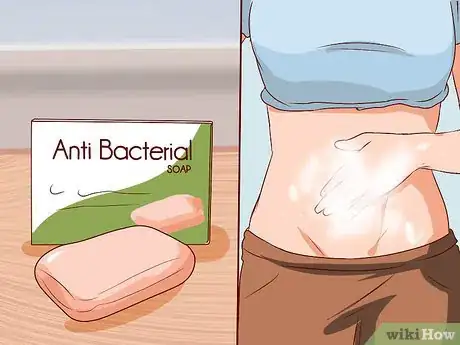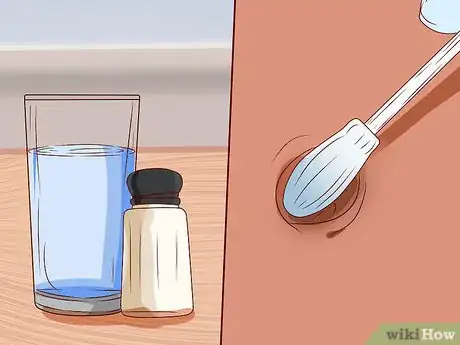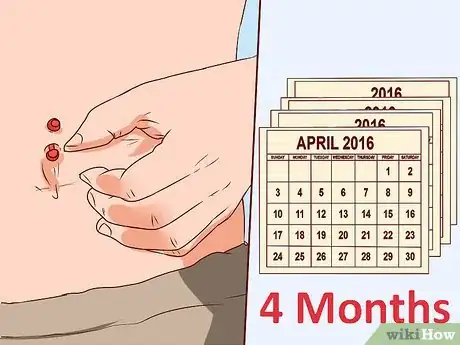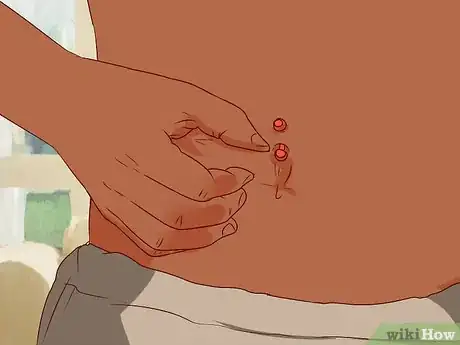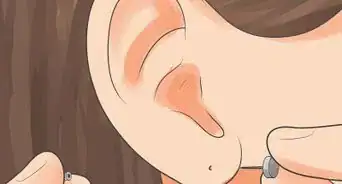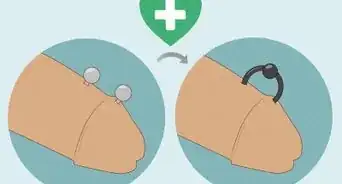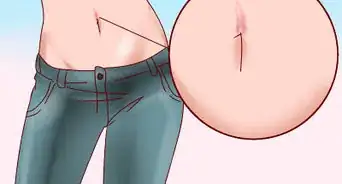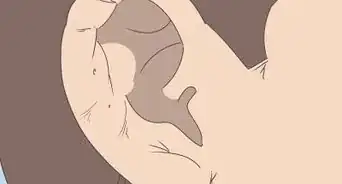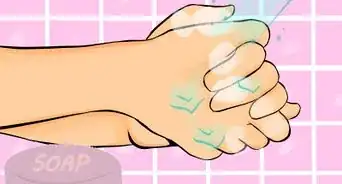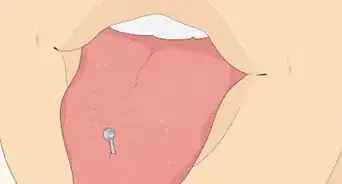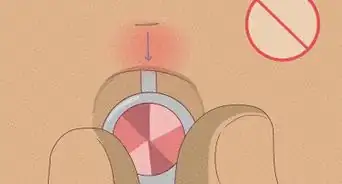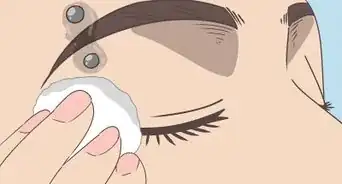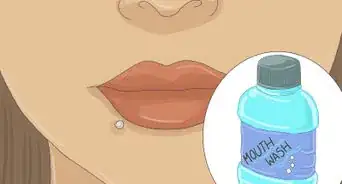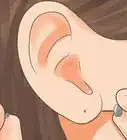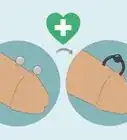This article was co-authored by wikiHow Staff. Our trained team of editors and researchers validate articles for accuracy and comprehensiveness. wikiHow's Content Management Team carefully monitors the work from our editorial staff to ensure that each article is backed by trusted research and meets our high quality standards.
This article has been viewed 1,372,990 times.
Learn more...
Navel piercings are becoming more and more popular. Some people choose to do it themselves for many reasons. If you choose to, read on. However, note that it is always safer to go to a professional.
Things You Should Know
- Prepare for a piercing by making sure your area (and your hands) are clean. Then, mark the spot where the piercing will enter and exit your bellybutton.
- Use a hollow needle and pierce from the bottom up. Then, insert the belly button ring through the center of the needle without removing the needle.
- Look out for infection in the following weeks. Avoid swimming and clean both ends of the piercing with a salt solution, too.
Steps
Preparing to Pierce
-
1Gather the correct equipment. Using the correct equipment for piercing your belly button is essential. Otherwise, the piercing could go badly wrong or result in a nasty infection.[1] To pierce your belly button in the safest way possible, you will need:
- A 14 gauge sterile piercing needle, a 14 gauge belly button ring made from stainless steel, titanium or bioplast, some rubbing alcohol or alcohol wipes, a body ink marker, a piercing clamp and some cotton balls.
- Using a sewing needle, safety pin or piercing gun to pierce your belly button is a bad idea, as these items are unsafe and will not produce good results.
-
2Create a hygienic environment. Before you proceed with piercing your belly button, you will need to take all precautions necessary to eliminate the chance of getting infected.[2] Spray any used countertops or tables with a disinfectant (not an antiseptic).Advertisement
-
3Wash your hands. Don't forget to wash your hands (and lower arms) in warm water! Everything needs to be completely sterile. An even safer precaution is wearing latex gloves (if they're sterile and haven't been sitting out). Dry your hands with a paper towel--not a cloth towel that's porous and attracts bacteria.[3]
-
4Sterilize the clamp, piercing needle and belly button ring. If you have bought all of these items (which you should have) they should be in sterile packaging. However, if they did not, or you have handled them already, you will need to sterilize them yourself before piercing.
- You can do this by submerging the items in rubbing alcohol or hydrogen peroxide and leaving them to sit in the liquid for a minute or two.
- Remove them from the liquid (wearing clean latex gloves, if possible) and leave them on a clean piece of paper towel to dry completely.
-
5Clean around the belly button. Before piercing, it is necessary to thoroughly clean in and around the belly button to remove any bacteria from the surface of the skin. It's best to use a disinfecting skincare gel especially designed for piercings (such as Bactine) or rubbing alcohol.[4]
- Generously apply the disinfectant or rubbing alcohol to a cotton ball and wipe thoroughly around the area to be pierced. Wait for the area to dry completely before proceeding.
- If you are using rubbing alcohol, it's important to use one with a concentration of above 70% isopropanol, to achieve the necessary level of disinfection.
- If necessary, use a Q-Tip or other similar device to get inside your navel. Make sure to clean both above and below the piercing site.
-
6Make a mark where the piercing should be. Before you pierce, you will need to have some idea of where the needle is going, so using a body ink marker to mark the entrance and exit locations of the needle is a good idea.There should be approximately 1 cm (.4 inches) between the navel and the pierced hole.[5]
- Belly button piercings are typically located at the top of the belly button, rather than the bottom, but the choice is yours.
- Use a small hand-held mirror to check if the two marks are aligned horizontally and vertically. Only do this while standing, as your stomach scrunches up when sitting and will not give you a straight pierce.
-
7Decide whether you want to numb the area. Some people who are squeamish about pain may want to numb the skin around the belly button with an ice cube wrapped in paper towel before proceeding.
- However, it is important to be aware that numbing the area with ice will also make the skin tough and rubbery, making it harder to push the piercing needle through.
- Alternatively, you can apply a little numbing gel (such as those used for numbing gums before injections) to the area using a q-tip.
-
8At this point you may want to unscrew the ball from the top of the belly button ring (leave the bottom intact). You don't want to be fumbling with this while struggling to hold both the clamp and the needle in place.
Piercing the Belly Button
-
1Clamp the cleaned area. Now you are ready to begin! Take the piercing clamp and use it to clamp the skin of the navel and pull it out from the body slightly.[6]
- The entrance point you marked with the body ink should be centered in the bottom half of the clamp, while the exit point should be centered on the top half.
- Make sure to hold the clamp with your weaker hand, as you want the stronger, steadier one holding the needle.
-
2Prepare the needle. Take the sterilized, 12-gauge piercing needle (the 14-gauge jewelry will not fit inside a 14-gauge needle). This needle has a hollow center, which will allow you to easily insert the belly button ring once you have pushed the needle through.[7]
-
3Pierce from the bottom up. Align the sharp end of the needle with the mark on the underside of the clamp. Take a deep breath, then with one fluid movement push the needle through the skin, making sure that the needle exits through the mark at the top of the clamp.
- Never pierce from the top down. You need to be able to see where your needle is going and you can't do this if you're piercing downwards.
- The best way to pierce is while standing up, as this will give you the most mobility and allow you to see what you're doing. However, if you're concerned about fainting, pierce while lying down (not sitting!).
- Don't be concerned if the piercing bleeds a little -- this is totally normal. Just wipe away the blood with a clean q-tip dipped in saline solution.
-
4Insert the belly button ring. Place the end of the jewelry without the ball into the hollow needle (it should be virtually flush or slightly smaller than the needle) and push the needle out with the jewelry. DO NOT pull the needle out. You want to keep the contact between the needle and your navel ring for a smooth transition. The needle will fall off the end of the jewelry as it exits the skin so be prepared to catch it.[8]
- Refrain from pulling the needle out to soon, before the jewelry is fully through!
- Take the loose ball and screw it tightly onto the top of the belly button ring. Tah-dah! Your belly button is pierced!
-
5Clean your hands and the piercing. As soon as you've finished, wash your hands with antibacterial hand soap. Then take a cotton ball soaked in a saline solution or a cleaning solution and very gently clean around the piercing.[9]
- This is the first day of your cleaning regimen and arguably the most important. Take a few minutes to be thorough.
- Don't tug at your new piercing. Clean it and leave it alone to heal. Touching it or playing with it will only lead to infection, which is the last thing you want.
Following the Correct Aftercare Procedures
-
1Take care of your piercing. The work isn't over yet! Remember that a new piercing is like an open wound, so it is extremely important that you maintain a strict cleaning regimen over the next couple of months, since you're basically dealing with an injury or a scar. You will need to keep this up until the piercing heals completely, in order to prevent any itching and infection.[10]
- Wash the piercing with antibacterial soap once a day. Avoid rubbing alcohol, peroxide, or ointments, as these can be very drying and irritating on the skin if used everyday.
-
2Clean with a salt solution. A great way to keep your new piercing clean and free of infection is to use a salt solution. You can buy a saline solution at a drugstore or piercing studio, or you can simply dissolve some non-iodized sea salt in a cup of warm water.[11]
- Dip a q-tip in the solution and use it to carefully clean around both ends of the piercing.
- Gently push the jewelry from one side to the other in order to clean the ring as well.
-
3Avoid swimming in any water. Whether it's a pool, a river, or a hot tub, stay away for the first few months, as the water can harbor bacteria which can easily infect your new piercing.[12]
-
4Allow the piercing time to heal. If you see a clear or white liquid, it's healing properly. Anything with color or smell is infected and should be seen by a doctor.[13]
- Some professionals advocate a stringent care routine for up to 4-6 months. After 2 months, assess how your piercing is doing.
- Don't mess with it! Allow it to heal before you go changing rings. You may replace the balls, but don't touch the barbel. This will not only inflict pain but also slow the healing process.
-
5Keep an eye out for infection. Even after it seems healed, your piercing can get infected. If you suspect an infection (signs include swelling, tenderness, bleeding or seeping) apply a warm compress to the area every three to four hours, then clean with an antiseptic cleanser and apply a topical antibacterial cream.[14]
- If you don't see an improvement within 24 hours, consult your doctor.
- If a doctor isn't an option, see a professional piercing artist. They will help you adjust your care routine and give you professional products.
- Never take the belly button ring out when dealing with an infection - this only runs the risk of the infection becoming trapped inside the piercing.
Community Q&A
-
QuestionWhat if you don't have a clamp?
 Community AnswerYou can use the silver part of a binder clip or butterfly clip to hold the skin tight.
Community AnswerYou can use the silver part of a binder clip or butterfly clip to hold the skin tight. -
QuestionAt what age can I get my belly button pierced?
 Community Answer16 with parental consent in most places for it to be legal. I wouldn't do it before then, and some people choose to wait till they're 18 since your body is still growing and this can increase your chance of the body rejecting the piercing.
Community Answer16 with parental consent in most places for it to be legal. I wouldn't do it before then, and some people choose to wait till they're 18 since your body is still growing and this can increase your chance of the body rejecting the piercing. -
QuestionCan I have a shower after doing the piercing?
 Community AnswerYes, but maybe put something over your belly button piercing for the first few times.
Community AnswerYes, but maybe put something over your belly button piercing for the first few times.
wikiHow Video: How to Pierce Your Own Belly Button at Home
Warnings
- Do not use any products lying around the house. They are not safe and will cause infection.⧼thumbs_response⧽
- This can cause scarring if you choose not to wear a stud later in life.⧼thumbs_response⧽
- Do not use a piercing gun. Piercing guns are extremely unsterile and pierce using blunt force.⧼thumbs_response⧽
- Doing this yourself is dangerous. If you're dead set on getting your navel pierced, the best idea is to go to a professional.⧼thumbs_response⧽
- This is not suitable for anyone under the age of 13.⧼thumbs_response⧽
Things You'll Need
- Sterile hollow needle (12 gauge). You can also use a cannula needle to thread the jewelry easier.
- Body marker
- Rubbing alcohol or other skin disinfectant
- Clamps/tweezers
- Sterile starter jewelry (14 gauge and 18mm to allow for swelling. Bioplast or bioflex is best because it can bend with the body and can be cut down to a shorter length when swelling goes down.)
- Sterile latex gloves (optional but highly recommended)
References
- ↑ https://www.youtube.com/watch?v=F4V0Vq5DkcY
- ↑ https://www.youtube.com/watch?v=WHkQhwo3PM0
- ↑ https://www.youtube.com/watch?v=WHkQhwo3PM0
- ↑ https://www.youtube.com/watch?v=WHkQhwo3PM0
- ↑ https://www.youtube.com/watch?v=WHkQhwo3PM0
- ↑ https://www.youtube.com/watch?v=F4V0Vq5DkcY
- ↑ https://www.youtube.com/watch?v=F4V0Vq5DkcY
- ↑ https://www.youtube.com/watch?v=F4V0Vq5DkcY
- ↑ https://www.youtube.com/watch?v=WHkQhwo3PM0
- ↑ https://uhs.berkeley.edu/health-topics/body-piercings
- ↑ https://www.safepiercing.org/aftercare
- ↑ https://www.safepiercing.org/aftercare
- ↑ https://www.safepiercing.org/aftercare
- ↑ https://myhealth.alberta.ca/Health/aftercareinformation/pages/conditions.aspx?hwid=abk1292
- ↑ https://www.safepiercing.org/aftercar
About This Article
It’s always safest to get your belly button pierced by a professional. But if you choose to do it at home, here’s how. You’ll need a body piercing clamp, a 14-gauge piercing needle, and a 14-gauge belly button ring made of a safe material like stainless steel or titanium. You’ll also need rubbing alcohol and a body marker. Wipe down the surface where you plan to put your equipment with a disinfectant, then wash your hands thoroughly with soap and water. Submerge all your equipment in rubbing alcohol or hydrogen peroxide for 1-2 minutes, then lay it out on a paper towel to dry. Next, clean the area in and around your belly button with alcohol wipes or a cotton swab dipped in a skin-safe disinfectant. Use the marker to draw two marks where you want the needle to enter and exit your skin, just above your belly button. When you’re ready to pierce, unscrew the ball from the top of the belly button ring. Use the piercing clamp to grab the skin you’d like to pierce and pull it gently away from your body. The marks you drew should be centered in the middle of the openings on the clamp. Line up the point of the piercing needle with the bottom mark, take a deep breath, and push the needle through the clamped skin in one quick, fluid movement. Don’t pull the needle all the way through. Instead, load the top end of the belly button ring into the hollow end of the needle and then use the jewelry to push the needle up and out. When you’re sure the jewelry is all the way through the piercing, remove the needle and screw the ball back onto the top end of the belly button ring. As soon as you’re done, clean your hands with soap and water and gently clean the piercing with a cotton ball or pad soaked in saline solution. Clean your new piercing with soap and water or saline solution once a day. If you notice signs of an infection, such as increasing redness or swelling, a bad odor, or greenish or yellow discharge coming from the wound, see a doctor. For more tips, including how to look after your new piercing, read on!
